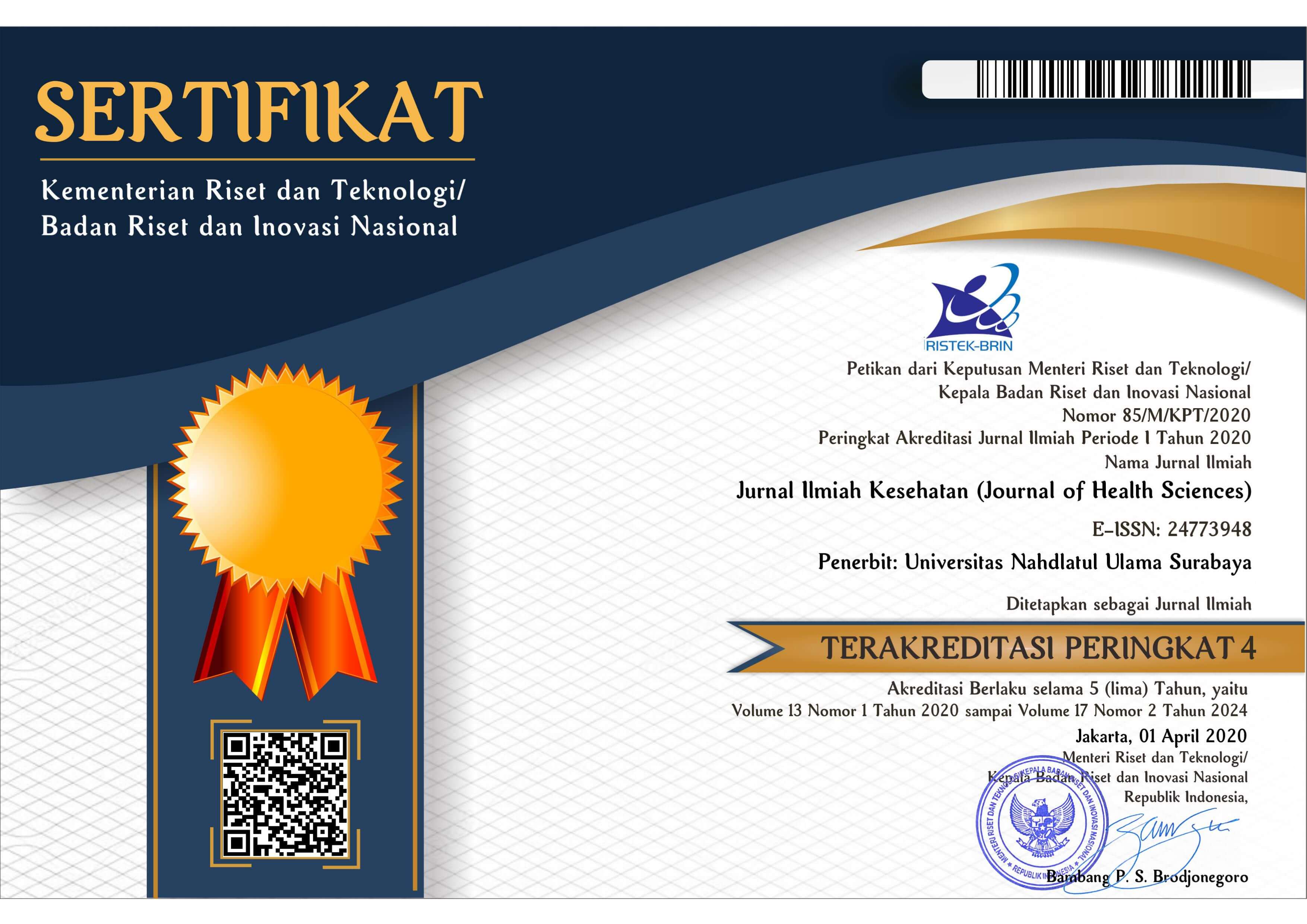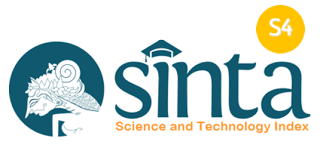Type and Duration of Mask Use Related To Acne Vulgaris During The Pandemic Period
DOI:
https://doi.org/10.33086/jhs.v15i03.2875Keywords:
Type of mask, duration of mask use, acne vulgarisAbstract
The masks' use has been a suggested strategy to counter COVID-19 transmission throughout this disease outbreak; however, wearing masks tightly closed for an extended period can cause acne vulgaris. The mask's form and duration of use are two factors that may affect the occurrence of acne vulgaris. Therefore, more research is needed to determine the impact of using masks on the prevalence of acne vulgaris. This study aimed to analyze the relationship between the type and duration of mask use and the prevalence of acne vulgaris in the citizens of Kawistowindu Village during the pandemic. This study used an analytical-observational study with a cross-sectional approach, with a sample of 63 people who met the inclusion and exclusion criteria throughout the neighborhood of RT.02 RW.01 Kawistowindu Village. The sample was chosen using a simple random sampling technique. Questionnaire forms, history-taking instruments, and physical examination techniques were used to collect data—the analysis used the Chi-Square test. The results showed that during the pandemic era, there was a significant correlation between the type of mask and the duration of mask use with the occurrence of acne vulgaris (p=0.000; p=0.004). In conclusion, in the pandemic era, the mask form and duration of mask use could be linked to acne vulgaris
Downloads
References
Alkubaisi, T. (2020). Annoying Skin Reaction Among the Medical Staff Using Personal Protective Equipment During COVID-19. 1–17. DOI: https://doi.org/10.21203/rs.3.rs-56574/v1
CDC, & Centers for Disease Control and Prevention. (2020). Use of Cloth Face Coverings to Help Slow the Spread of COVID-19. Www.Cdc.Gov, 4–6.
Chua, M. H., Cheng, W., Goh, S. S., Kong, J., Li, B., Lim, J. Y. C., Mao, L., Wang, S., Xue, K., Yang, L., Ye, E., Zhang, K., Chet, W., Cheong, D., Tan, H., Li, Z., & Tan, B. H. (2020). Review Article Face Masks in the New COVID-19 Normal: Materials, Testing, and Perspectives. https://doi.org/10.34133/2020/7286735 DOI: https://doi.org/10.34133/2020/7286735
Dréno, B., Bettoli, V., Araviiskaia, E., Sanchez Viera, M., & Bouloc, A. (2018). The influence of exposome on acne. Journal of the European Academy of Dermatology and Venereology, 32(5), 812–819. https://doi.org/10.1111/jdv.14820 DOI: https://doi.org/10.1111/jdv.14820
Dwirusman, C. G. (2020). Peran dan Efektivitas Masker dalam Pencegahan Penularan Corona Virus Disease 2019 (COVID-19). Medika Hutama, 02(01), 377–381.
Foo, C. C. I., Goon, A. T. J., Leow, Y. H., & Goh, C. L. (2006). Adverse skin reactions to personal protective equipment against severe acute respiratory syndrome - A descriptive study in Singapore. Contact Dermatitis, 55(5), 291–294. https://doi.org/10.1111/j.1600-0536.2006.00953.x DOI: https://doi.org/10.1111/j.1600-0536.2006.00953.x
Gomolin, T. A., Cline, A., & Russo, M. (2020). Maskne: Exacerbation or Eruption of Acne During The COVID-19 Pandemic. The National Society for Cutaneous Medicine, 4(5), 438–439. DOI: https://doi.org/10.25251/skin.4.5.7
Han, C., Shi, J., Chen, Y., & Zhang, Z. (2020). Increased flare of acne caused by long-time mask wearing during COVID-19 pandemic among general population. In Dermatologic Therapy (Vol. 33, Issue 4). Blackwell Publishing Inc. https://doi.org/10.1111/dth.13704 DOI: https://doi.org/10.1111/dth.13704
Hidajat, Dedianto. (2020). Maskne: Akne Akibat Masker. Jurnal Kedokteran, 9(2), 202-205. DOI: https://doi.org/10.29303/jku.v9i3.433
Howard, J., Huang, A., Li, Z., Tufekci, Z., Zdimal, V., & Westhuizen, H. van der. (2020). Face Masks Against COVID-19: An Evidence Review. April 1–8. https://doi.org/10.20944/preprints202004.0203.v1 DOI: https://doi.org/10.20944/preprints202004.0203.v1
Hua, W., Zuo, Y., Wan, R., Xiong, L., Tang, J., Zou, L., Shu, X., & Li, L. (2020). Short-term skin reactions following use of N95 respirators and medical masks. Contact Dermatitis, 83(2), 115–121. https://doi.org/10.1111/cod.13601 DOI: https://doi.org/10.1111/cod.13601
Kementrian Kesehatan RI. (2020a). Dokumen resmi. Pedoman Kesiapan Menghadapi COVID-19, 0–115.
Kementrian Kesehatan RI (2020b). Pedoman Pencegahan dan Pengendalian Corona Virus deases (Covid-19). Kementrian Kesehatan, 5, 178. https://covid19.go.id/storage/app/media/Protokol/REV-05_Pedoman_P2_COVID-19_13_Juli_2020.pdf
Kian Teo Tan, Greaves M W. (2004). N95 acne. International Journal of Dermatology. 43 : 522–523. DOI: https://doi.org/10.1111/j.1365-4632.2004.02338.x
Lan, J., Song, Z., Miao, X., Li, H., Li, Y., Dong, L., Yang, J., An, X., Zhang, Y., Yang, L., Zhou, N., Li, J., Cao, J. J., Wang, J., & Tao, J. (2020). Skin damage among health care workers managing coronavirus disease-2019. Journal of the American Academy of Dermatology, 82(5), 1215–1216. https://doi.org/10.1016/j.jaad.2020.03.014 DOI: https://doi.org/10.1016/j.jaad.2020.03.014
Pervun, J., & Babenko, O. (2021). “MASKNE”: PROBLEM DURING QUARANTINE. HOW TO PREVENT ACNE BREAKOUTS?
Rudd, E., & Walsh, S. (2021). Mask related acne (“maskne”) and other facial dermatoses. In The BMJ (Vol. 373). BMJ Publishing Group. https://doi.org/10.1136/bmj.n1304 DOI: https://doi.org/10.1136/bmj.n1304
Searle, T., Ali, F. R., & Al-Niaimi, F. (2021). Identifying and addressing “Maskne” in clinical practice. In Dermatologic Therapy (Vol. 34, Issue 1). Blackwell Publishing Inc. https://doi.org/10.1111/dth.14589 DOI: https://doi.org/10.1111/dth.14589
Susilo, A., Rumende, C. M., Pitoyo, C. W., Santoso, W. D., Yulianti, M., Herikurniawan, H., Sinto, R., Singh, G., Nainggolan, L., Nelwan, E. J., Chen, L. K., Widhani, A., Wijaya, E., Wicaksana, B., Maksum, M., Annisa, F., Jasirwan, C. O. M., & Yunihastuti, E. (2020). Coronavirus Disease 2019: Tinjauan Literatur Terkini. Jurnal Penyakit Dalam Indonesia, 7(1), 45. https://doi.org/10.7454/jpdi.v7i1.415 DOI: https://doi.org/10.7454/jpdi.v7i1.415
Techasatian, L., Lebsing, S., Uppala, R., Thaowandee, W., Chaiyarit, J., Supakunpinyo, C., Panombualert, S., Mairiang, D., Saengnipanthkul, S., Wichajarn, K., Kiatchoosakun, P., & Kosalaraksa, P. (2020). The Effects of the Face Mask on the Skin Underneath: A Prospective Survey During the COVID-19 Pandemic. Of Primary Care & Community Health, 11, 1–7. https://doi.org/10.1177/2150132720966167 DOI: https://doi.org/10.1177/2150132720966167
Teo, W. L. (2021). The “Maskne” microbiome – pathophysiology and therapeutics. In International Journal of Dermatology (Vol. 60, Issue 7, pp. 799–809). John Wiley and Sons Inc. https://doi.org/10.1111/ijd.15425 DOI: https://doi.org/10.1111/ijd.15425
Wang, J., & Du, G. (2020). COVID-19 may transmit through aerosol. Irish Journal of Medical Science, 189(4), 1143–1144. https://doi.org/10.1007/s11845-020-02218-2 DOI: https://doi.org/10.1007/s11845-020-02218-2
Downloads
Published
How to Cite
Issue
Section
License
Copyright (c) 2022 Dwi Rahmatul Adha Ghozali, Retno Indrastiti, Kanti Ratnaningrum

This work is licensed under a Creative Commons Attribution-ShareAlike 4.0 International License.




















